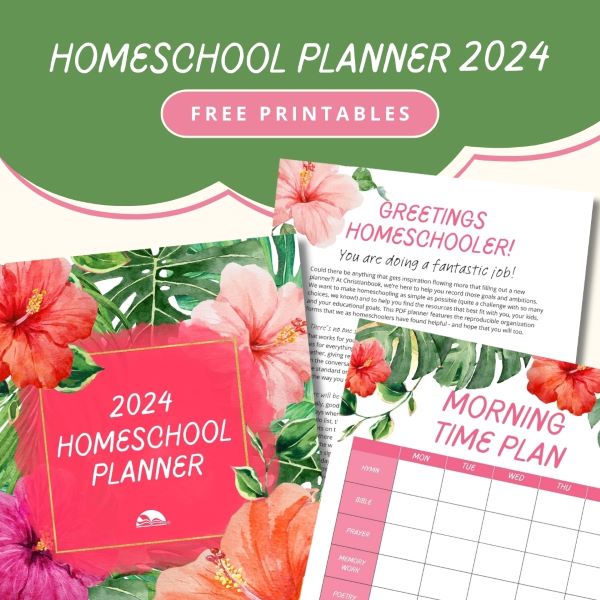This time of year our inbox is full of homeschool planning questions. If you’re new to homeschooling, the thought of taking responsibility of your child’s education and mapping out their entire school year can be quite daunting.
Today I’m going to walk you through my personal planning process, breaking the whole overwhelming process down into smaller tasks so you can take it one step at a time.
Your process may look different. That’s ok! This is just one example of how this can look. Take what’s helpful to you, and leave the rest.
The one step I encourage you not to leave out is prayer. Homeschooling stretches us to the very limits of our capacity physically, mentally, emotionally, and spiritually. Trying to undertake this job apart from the help and strengthening of the Holy Spirit is a recipe for burnout. So invite God into your homeschool planning process (and your homeschool days!). Seek His wisdom every step of the way. God desires to reach the hearts and minds of our children. He knows them inside and out. He understands how best to instruct them so let’s submit our planning to His direction.
If any of you lacks wisdom, let him ask God who gives generously to all without reproach, and it will be given to him.
James 1:5
Step One: Reflect on Last Year’s Homeschool
If this isn’t your first year homeschooling, I think it’s absolutely essential to pause and reflect on the previous year BEFORE you jump into planning your homeschool year. When you’ve taken time to analyze the choices that flopped and why they didn’t work for your family, you’ll be in a much better place to choose wisely for the upcoming year.
You can read my reflections on our school year last year with a 4th grader and a 6th grader here for an example of what this could look like.

Step Two: Map Out Our School Days
I like to print out a calendar that shows the entire school year on a single sheet and then mark our school days in one color and our days off in another color. Inevitably, we won’t follow this perfectly. Someone will get sick, a family crisis will occur, etc. But it’s nice to have as a general starting point.
There are many different ways to structure your school year. Choose one that fits your family or come up with your own way of doing it. Some states require a certain number of school days or hours of instruction. If yours does, make sure you take that into account when you’re marking out your days.
Traditional School Schedule
Model your calendar after whatever your local school district does (probably one long summer break and a few shorter stretches of time off throughout the year). The advantage of this schedule is your kids will be off at the same times as their traditionally schooled friends, neighbors, and cousins. They’ll also be available to participate in summer activities like camps and VBS.
Six Weeks On, One Week Off
Sometimes called Sabbath Schooling, this schedule breaks your school year up into six week terms with more frequent, but shorter breaks instead of one long summer break. You can push through the term knowing that a week off is coming to catch up on housework or larger projects. This schedule also makes it easier to schedule unit studies or subjects that you don’t need to do every day, but you’d like to cover for short, focused bursts.
Four Day a Week Schedule
Many homeschool families do bookwork Monday through Thursday and save the fifth day for field trips, park days, and meet-ups with friends. Or you might participate in a co-op or church activity that meets one day a week so you fit your school work into the remaining four weekdays. Adding Fun Friday, Field Trip Friday, or Freedom Friday to your weekly rhythm can be a great motivator to help your kids focus and be productive during the week knowing that a change of pace is coming (while you can rest in the knowledge that they’re learning just as much from these spontaneous adventures as they are from their regular bookwork, maybe more!).
Off Hours Schedule
For single parent families or families where both parents are working outside the home, homeschooling may work best if you strategically use evenings and weekends for schoolwork. (The book Homeschool Hacks by Linsey Knerl is a great resource for you if you’re planning to combine working and homeschooling.) You may also find this approach helpful if you’re in a season with lots of little ones. Saving some intensive schoolwork to do in the evenings or on weekends when Dad is home to supervise toddlers and preschoolers may be a lifesaver in certain chaotic seasons.
Homeschool Year Round
Some families have a daily homeschool routine that they follow all-year round, taking days off as needed, when someone is sick, or when the weather is beautiful outside and everyone just wants to relax. If you are a family that values spontaneity and flexibility, you may find that your family thrives with a year-round approach.
There’s no one right way to structure your homeschool days. Many families use a combination of these approaches. Choose what you think might work for your family, try it for a season, and tweak as needed. Homeschooling is an endless process of refining and pivoting, failing and starting again. Don’t be beholden to your plan, but also don’t be too quick to throw in the towel when you encounter resistance. Seek God’s wisdom, and follow His leading.
Step Three: Brainstorm for Each Child, Then Prioritize
At this point I get a blank piece of paper for each child, and brain dump every possible thing I’d like to cover with that child. This is my opportunity to get all the ideas swirling around in my head down on paper. I include everything from academic subjects to extracurriculars and church activities. On the back of the page I often jot down specific field trips, read-alouds, Scripture memory verses, life skills, etc. that I don’t want this child to miss. Here’s my actual messy scribbling as I brainstorm for my 7th grader this year:

Once I have everything down on paper, I sit with this page for a few days or weeks, praying over how to prioritize from here. I cannot give all these areas equal attention or time in our schedule. As I pray, I try to identify my top 3 priorities for each child and then refine further to the #1 priority for each of them. Then I write this down and tape it to the inside cover of my journal where I can refer back to it frequently. This helps refocus me in the seasons where I feel like we are accomplishing nothing.
Step Four: Think Through Daily and Weekly Rhythms
Once I’ve established what my main priorities are for each child, I get a fresh sheet of paper and break everything on my brainstorming page down into one of five categories:
- Daily subjects for independent work
- Weekly independent subjects
- Subjects for our gathered read-aloud time (morning time)
- Subjects to put on a loop
- Subjects that would be nice to get to, but not essential for this year
Dividing everything up into these different buckets helps me recognize where I’m being unrealistic. If I have 17 subjects for my 7th grader to work on independently every day, I am setting us all up for failure. Some things that I’d love to do every day usually need to be just once a week. Others may need to go on a loop. And there are always things I’d love to get to that realistically aren’t essential. Praying through my priorities helps me feel comfortable landing these things on the nice, but not essential list.
I try to keep in mind these wise words from Sarah Mackenzie in Teaching from Rest:
Are you loading your backpack at the beginning of each new year with everything you think you may need or want for your journey? Or have you pared back? I assure you that by February – a mile into the trail – if your pack is weighed down by nonessentials, you’ll feel as though you want to quit. The only way to combat that is to make sure that you aren’t carrying too heavy a load in the first place.
It is much more enjoyable to discover that you have extra margin in your schedule and add more things in later than it is to drop books or whole subjects in defeat because you’ve bitten off more than you (and your kids) can chew.
Step Five: Decide What Materials to Use for Each Subject
Now comes the fun part of picking which curriculum to use! I go through the curriculum I already have and see what we can use in the coming year (that way I don’t spend money on books we already have – oops!). I make lists of books we’ll use for history and literature and figure out which ones I can get through the local library and which ones I’ll want to own. And I ask trusted fellow homeschoolers what curriculum has worked well for them.
If you need help deciding which curriculum to use, don’t hesitate to reach out to Christianbook and connect with one of their homeschool specialists (call 1-800-CHRISTIAN or email customer.service@christianbook.com). They are a team of experienced current and former home educators who will take the time to talk to you about your unique situation and give you curriculum recommendations tailored to your family. This is an amazing free resource for homeschool parents!
More Homeschool Planning Help
If you’d like more help planning your homeschool year, I highly recommend the book Plan Your Year by Pam Barnhill.
You might also enjoy some of these articles:
- 4 Questions to Ask When Choosing Your Homeschool Curriculum
- Homeschool Planning Using Checklists and Schedules
- 3 Questions to Ask As You Plan Your Homeschool Year
- Home Organization and Time Management Tips
- Making a Homeschool Schedule
- 4 Ways to Work Smarter, Not Harder in Your Homeschool
Don’t forget to download your FREE printable homeschool planning pages from Christianbook!
This post contains affiliate links. Thank you for supporting the Homeschool Compass by shopping through our page!
Enjoy this post? Read on, and sign up for our homeschool newsletter!
10 Options for Homeschooling Through High School
